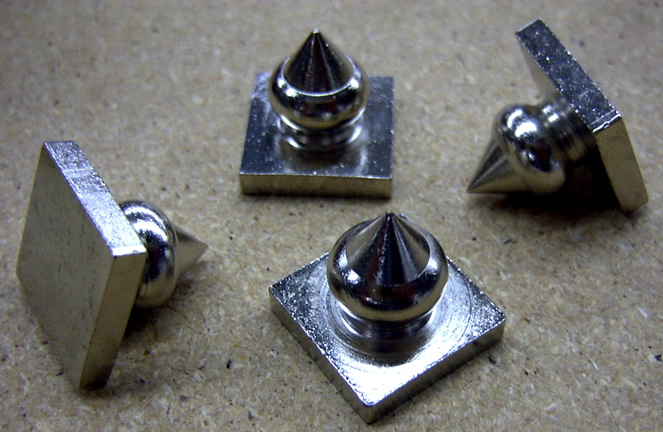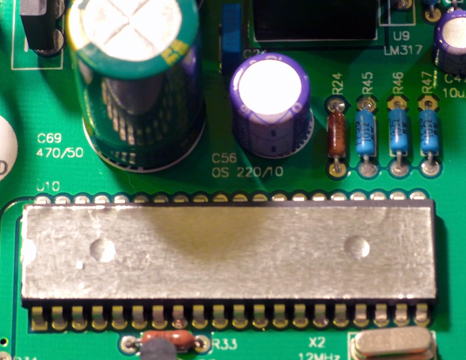Home | Audio | DIY | Guitar | iPods | Music | Brain/Problem Solving | Links| Site Map
This work is licensed under a Creative Commons License.
Easy Audio Component Mods
Eliminate Vibration
Several things can be done to eliminate any vibration from your audio component.
Isolation Feet
Use isolation feet. One can use the typical four point pattern for the feet or go with a three point pattern (two in the front and one in the back.) I use some Hi-Fi Tips available from Monarchy Audio. For the price these cannot be beat. To try and maximize the amount of surface area that touches the surface that they are used on, I place a nickle under each tip (compare the edge of a nickle to other coins and you will see why I chose a nickle.)
 |
| Above: Monarchy Audio Hi-Fi Tips |
Dampening
For dampening and anti-vibration I use 3M Sound Deadening Pads that were placed where ever vibration may occur, and on the inside of the bottom, top, and sides of the case. These pads added considerable weight to the unit. If these pads cannot be acquired then self-adhesive sound deadening mats that are used in automobiles may be used. An advantage of these types of mats is that some of them have an aluminum foil surface that will help in shielding EMI/RFI.
 |
| Above: The top of a NM24 has been dampened using 3M Sound Deadening Pads. Care should be taken to not cover vent openings, screw holes, etc. You should also make sure that you leave enough clearance so that the cover can be used without any obstructions caused by the dampening material. Due to the price of the dampening material all scraps are used; hence, the irregular pieces. Use the material on the base as well. For heat-sinks, a small 1/4" square piece on the inside of each cooling fin will stop the fin from ringing. It is not necessary to use a larger piece than this, and to test it merely apply the 1/4" piece and then tap the fin with a screw driver both before and after the application to hear the difference. |
Shield All IC's from EMI/RFI
To reduce EMI/RFI then all IC’s should be covered with anti-EMI/RFI tape. This is a slow process, and care must be taken not to allow the shielding tape to touch any of the any metal legs coming from the ICs, thus shorting out the IC. Not only should all OP Amps be covered, but also the DAC chip, and all other ICs. If the toroidal transformers are not in a separate unit, then shielding tape can also be used to cover them. Use the tape liberally. Here is the type of tape you want, and will cut to size.
 |
 |
 |
Tube Dampers
There is some controversy when it comes to tube dampers; some swear by them and others think they do nothing to improve the quality of the audio at all. Personally, I realized I needed some dampers when my tubes started producing a high-frequency sound when they were on for more than an hour. The solution was obvious, but the options were not. Tube dampers will run anywhere from $10 to well over $200. The dampers that you will learn how to build below will cost around $5 each. Initially they may appear to be a bit crude, but in reality they actually are rather sharp looking and add a "retro" look to your system.
Complete instructions on how to make tube dampers/heat dissipaters for less than $5 each.
Image 1: Completed tube damper on a 6AS7 tube
Home | Audio | DIY | Guitar | iPods | Music | Links | Site Map | Contact